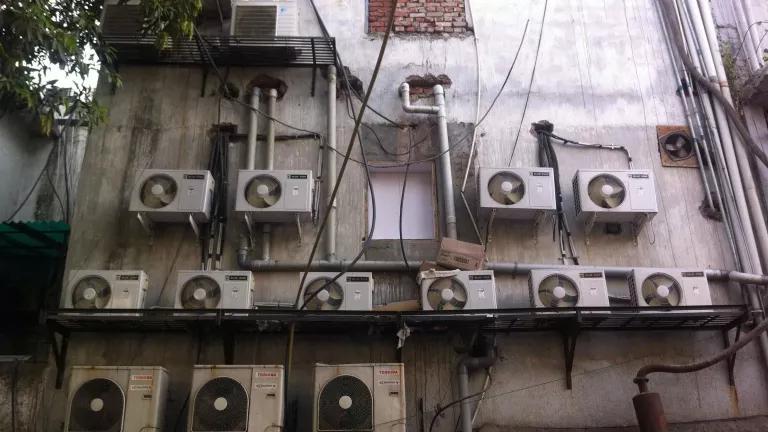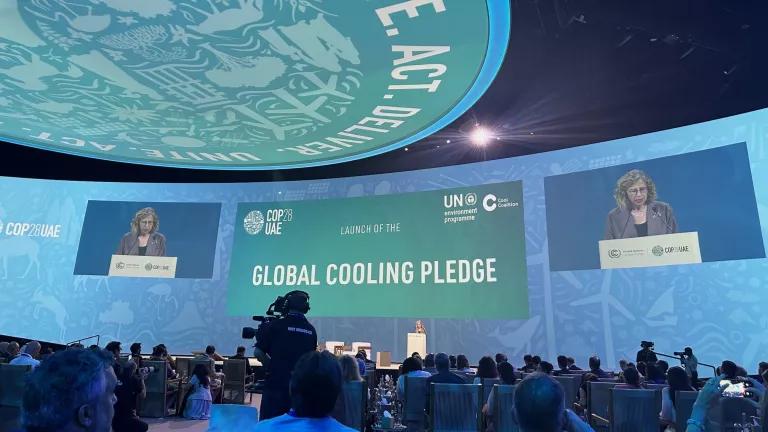Cooling with Less Warming: Updates from US, India and China
Find out the latest on sustainable cooling in the United States, India and China during the NRDC side event on Cooling with Less Warming during the Montreal Protocl meeting this week.

Air conditioners in New Delhi, India
Countries from around the world are gathering virtually this year for the 32nd Meeting of the Parties to the Montreal Protocol—a critical treaty for driving climate action. The discussions are centered on ensuring that funding continues to be available during the COVID-19 pandemic for developing countries to implement commitments under the Montreal Protocol. Earlier today, NRDC experts and special guests from the United States, India and China presented updates on cooling during a side event discussion on Cooling With Less Warming: Updates from US, India and China.
The specific Montreal Protocol items for the meeting include replenishment of the Multilateral Fund for the implementation of the protocol; nominations for methyl bromide critical-use exemptions for 2021 and 2022 and consideration of the membership of Montreal Protocol bodies for 2021. The Meeting of the Parties continues throughout this week with the plenary and several side-events.
After years of negotiations, Montreal Protocol Parties came together in 2016 to solve another global environmental problem—the HFC gases used to replace ozone-harming chemicals. HFCs are potent greenhouse gases that would add 0.5 degrees to global warming by 2100 if left uncontrolled. India played a key role in negotiating the successful Kigali Amendment, which expands the Protocol’s mandate to phase down harmful HFCs.
Building on historic successes of Montreal Protocol, the Kigali Amendment will avoid the use of HFCs equivalent of more than 70 billion tons of CO2 over the next 35 years, achieving a nearly 90% reduction in global warming resulting from unconstrained HFC use by century’s end. India and leading countries are moving forward with action to implement the Kigali Amendment and sustainable cooling efforts.
Updates from U.S., India and China at NRDC’s Side Event
To take a closer look at three main markets, NRDC brought together experts from the U.S., India and China during the side event to discuss a range of activities, including HFC phase down efforts, market developments and programs to reduce cooling energy demand through energy efficiency. While all three nations have yet to ratify the Kigali amendment, significant progress has been made on phasing down HFCs and sustainable cooling.
Special guests for the discussion included:
- Atul Bagai, Head-Country Office India, United Nations Environment Programme (UNEP) discussed UNEP cooling initiatives in India
- Kathryn Kynett, California Air Resources Board, discussed California’s new AC and refrigeration regulations
NRDC experts also provided updates:
- Alex Hillbrand, HFC Policy Advocate, Climate & Clean Energy and International Program, NRDC, provided an overall global update
- Prima Madan, Lead Cooling & Energy Efficiency Consultant, NRDC India Program provided updates on air conditioning market trends and other cooling initiatives in India
- Christina Theodoridi, Technical Analyst, Climate & Clean Energy Program, NRDC, provided an update on U.S. state action on HFCs
- Mona Yew, Deputy Director, NRDC China Program highlighted cooling action in China as well as new air conditioning standards & updated F-gas law
United States
The presentations on the U.S. focused on the current national legislation to phase down HFCs being considered in the U.S. Congress (in both the House and Senate) and stronger overall action for U.S. action under the Biden Administration. The pending federal legislation aims to phase down use of HFCs in the country over the next 15 years; require new production and import of HFCs fall from 100% to 15% of baseline by 2036; and encourage the Environmental Protection Agency (EPA) to implement HFC leak prevention and disposal requirements, including recycling, reclamation, and destruction; and authorizes EPA to ban HFCs in end-use applications where there are better alternatives. The proposed bill does not ratify Kigali Amendment but mandates compliance with the core obligations.
This promising progress on the federal legislation has been encouraged in part by determined action on HFCs at the U.S. state level. So far, 16 states have adopted or proposed rules that prohibit the use of HFCs in specific applications, including commercial refrigeration and building chillers. These states belong to the U.S. Climate Alliance, a coalition of 25 governors committed to acting on climate. The U.S. Climate Alliance members are responsible for 40% of the nation’s HFC emissions and account for more than half of the U.S.’s gross domestic product. State rules have been integral in keeping the U.S. HFC market in check.
California is a leader among states with a host of updates phasing down HFCs. California recently enacted groundbreaking legislation, Senate Bill 1383, that requires the state to reduce HFC emissions 40% below 2013 levels by 2030. The market in California is moving ahead with low-GWP refrigerants used in room air conditioners and supermarkets.
India
India’s Ministry of Environment, Forests and Climate Change (MOEFCC) along with key stakeholders have been moving forward to implement the India Cooling Action Plan, which embodies the Kigali Amendment’s goals to phase down HFCs and reduce cooling demand. The ICAP, released in March 2019, aims to achieve sustainable, equitable and more energy efficient cooling. MOEFCC and several stakeholders are working toward ICAP implementation focused on Kigali Amendment implementation, energy efficient room and mobile air conditioners, cold chain advancements, and reducing cooling demand through improved building energy efficiency and cool roofs.
UNEP is focusing on state level action by including sustainable cooling initiatives as part of India’s 28 state climate action plans to develop energy efficiency programs and initiatives to reduce cooling demand. To improve thermal comfort from extreme heat, UNEP is also working on with the 100 Smart Cities initiative to expand district cooling and working to expand energy efficiency building codes, as recently highlighted the NRDC and partners case study, “Building Smart from the Start: Implementation of Energy Saving Building Codes in Uttar Pradesh.” The COVID-19 pandemic has emphasized the need for sustainable cooling given the cold-chain for refrigerating vaccines and indoor comfort as more people social distance at home.
The air conditioning industry in India is moving forward with leapfrogging efforts from high-global warming potential (GWP) refrigerants (R-22 or R-410A) for room air conditioners to lower GWP solutions (R-32 or R-290). Nearly 7 companies are leapfrogging HFCs through the HPMP process to phase out ozone-depleting substances. Currently many room air conditioners use R-32. The market also has encouraging developments on R-290 natural refrigerants. Civil society programs are working to advance climate-friendly cooling, including projects such as Energy Efficiency Services Limited’s bulk procurement programs, the Global Cooling Prize, and the India Cooling Coalition.
India’s Star label program, run by the Bureau of Energy Efficiency (BEE), has made a significant impact on national energy use by driving down the energy consumption of individual appliances and increasing consumer awareness about energy efficiency. By 2030, room air conditioners make up over 50% of space cooling energy consumption in India, according to the Indian government – a central reason that ICAP prioritizes improving the efficiency of room air conditioners.
A recent audit by the Comptroller and Auditor General, an independent government authority in India, found that many air conditioners and refrigerators sold in the Indian market do not actually perform as indicated by the efficiency label, however. The audit suggests that in addition to opportunities for stronger standards, it is important to strengthen compliance testing and enforcement to ensure realization of the energy and climate benefits of stronger MEPS – as envisioned under the ICAP.
China
The China update focused on national highlights and advancements on room air conditioners. China produces 70% of the world’s air conditioners and buys 45% of them. More than 150 million units were sold in 2019, with approximately 40% for export.
The Green and High-Efficiency Cooling Action Plan adopted in 2019 sets targets for strengthening cooling efficiency. The Plan aims to improve residential air conditioners energy efficiency by 30% by 2022 and targets for other cooling appliances as well an additional 15% improvement for major cooling products by 2030.
China also passed a new minimum energy performance standard for room air conditioners, now among the most ambitious in the world, with an average 15% improvement in energy efficiency. The first step of the new standards became effective as of July 1, 2020, and once fully rolled out will reduce annual CO2 emissions by approximately 100 MMT/year in 2030, the equivalent to taking 2-3 dozen 500 megawatt powerplants off the grid.
As the Parties to the Montreal Protocol tackle HFC use within their own borders, they also sustain the international momentum to advance Kigali implementation and sustainable cooling. In this critical time with multiple threats – the COVID-19 pandemic, economic downturn, and the climate crisis—action on climate friendly cooling is vital to overcoming these global threats.
Highlighted NRDC Cooling Resources
- Improving Air Conditioners in India: Market Profile - Fact Sheet, 2018
- Improving Air Conditioners in India - Issue Brief, 2018
- Cooling India with Less Warming: Highlighted Resources and Briefing Materials for a Global HFC Phasedown under the Montreal Protocol - Fact Sheet, 2016
- Cooling India with Less Warming - Fact Sheet, 2014
- Cooling India with Less Warming - Issue Paper, 2013
This blog has been updated with the following information:
UNEP is focusing on state level action by proposing a guidance on sustainable cooling initiatives as part of the two state climate action plan revisions it is working on. To improve thermal comfort from extreme heat, UNEP is also working along with the Smart Cities initiatives to enhance the uptake of district cooling systems.
Civil society programs are working to advance climate-friendly cooling, including projects by the Council on Energy, Environment and Water, the Alliance for an Energy Efficient Economy, The Energy and Resources Institute, the Natural Resources Defense Council, among others. To clarify, EESL is an energy service company of the Government of India.





